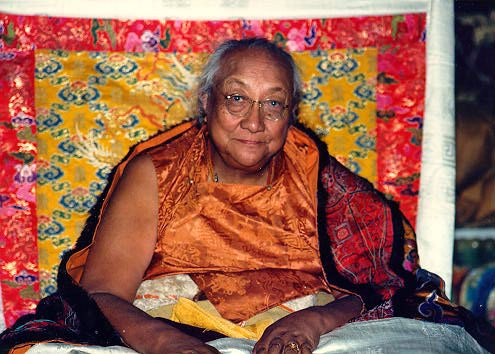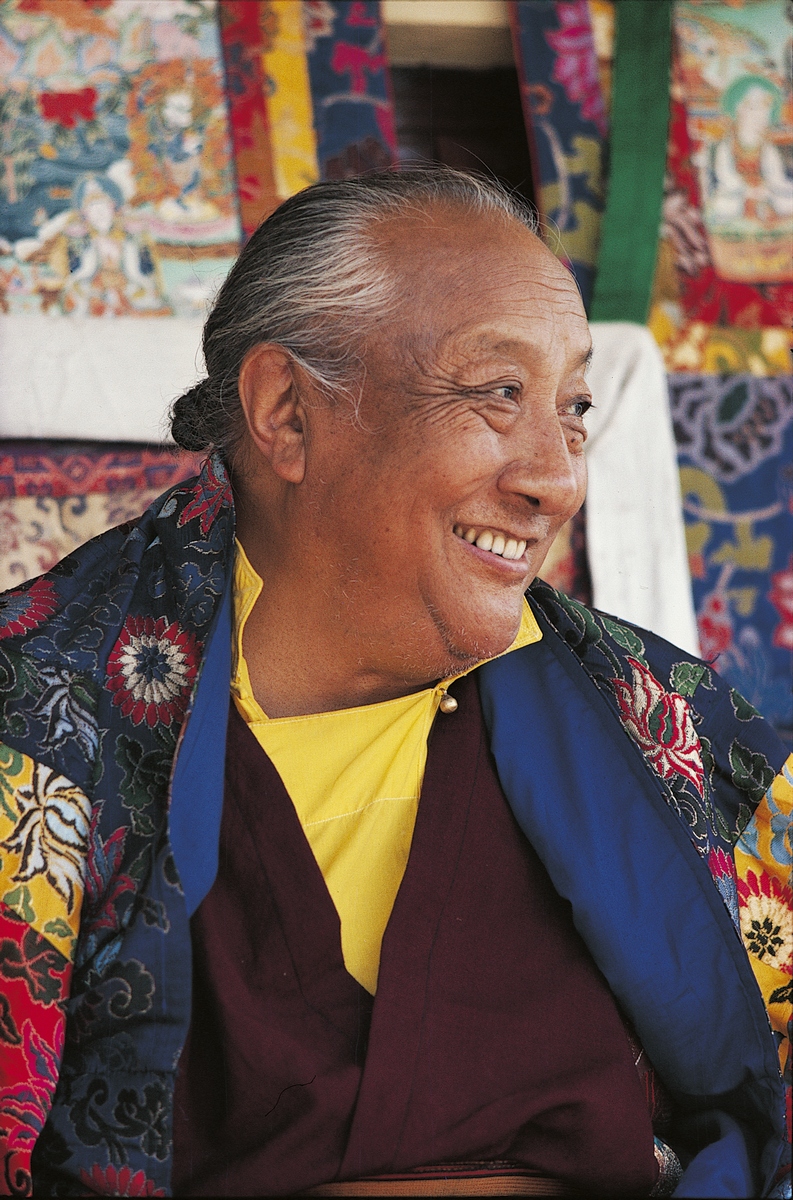Dilgo Khyentse Rinpoche

Dilgo Khyentse Rinpoche belonged to the last generation of great Tibetan masters who completed their entire education and training in Tibet.
Revered towards the end of this life as the supreme head of the Nyingma School and the spiritual director of the royal family of Bhutan, Dilgo Khyentse Rinpoche was a scholar and master of meditation of unsurpassed authority. He spent over twenty years of his life in solitary retreat, bringing the wisdom of learning, reflection and meditation to a level of supreme accomplishment.

Dilgo Khyentse Rinpoche was a tertön, a discoverer of spiritual treasures. He revealed many important cycles of teaching coming directly from Guru Padmasambhava. He was a prolific writer and a poet of great distinction. His collected works, comprising commentaries, practice texts, meditation instructions and numerous poems and prayers fill a collection of twenty-two volumes. Renowned for his ability to transmit the teachings of every Tibetan Buddhist school according to its own tradition, Dilgo Khyentse Rinpoche was an unrivaled upholder of the Tibetan Rimé or non-sectrarian movement, inaugurated in the nineteenth century by his predecessor Jamyang Khyentse Wangpo and Jamgon Kongtrul Lodro Thayé. He was thus the venerated master of many lamas of all four schools of Tibetan Buddhism. He was one of the leading masters of the teachings of the Great Perfection and one of the main holders of the Longchen Nyingtik tradition. The Dalai Lama has on numerous occasions referred to Khyentse Rinpoche as his principal teacher of the Great Perfection.

Dilgo Khyentse Rinpoche was born in 1910 in the valley of Denkhok in the east of Tibet. His family was of the royal lineage of king Trisongdetsen, and his father was a minister of the king of Derge. While still in his mother’s womb, he was recognized as an extraordinary incarnation by the great Mipham Rinpoche, who shortly after his birth bestowed on him a special empowerment of Manjushri and the name Tashi Peljor.

Even as a small boy, Rinpoche manifested a strong desire to devote himself entirely to the religious life. His father, however, had other plans. His two elder sons had already left home to become monks: one had been recognized as a tulku or incarnate lama, and the other wanted to become a doctor. Rinpoche’s father hoped for an heir who would inherit the extensive family estates, and he refused to accept that his third and youngest son might also be a lama—as several learned masters had already indicated.
At the age of ten, the boy was taken seriously ill and remained bed-ridden for almost a year. Respected lamas advised that unless he was allowed to embrace the religious life, he would not live long. Yielding to everyone’s entreaties, his father finally gave his son the freedom to follow his aspirations and fulfill his destiny.

So it was that, at the age of eleven years, Dilgo Khyentse Rinpoche entered the monastery of Shechen, one of the six principal monasteries of the Nyingma School. It was there that he met his root guru, Shechen Gyaltsap Rinpoche (the dharma heir of Mipham Rinpoche) who recognized and enthroned him as the mind-emanation of the great Jamyang Khyentse Wangpo.
The lamas belonging to the Khyentse lineage are considered to be emanations of the Bodhisattva Manjushri and incarnations of numerous important figures in the history of Tibetan Buddhism. These include Vimalamitra and King Trisongdetsen who, together with Guru Padmasambhava and the Abbot Shantarakshita established the entire range of Buddhist teachings in Tibet. The incarnations of the Khyentse lineage also include the two omniscient masters Gyalwa Longchenpa (fourteenth century) and the Vidhyādhara Jigme Lingpa (eighteenth century).
While at Shechen, Dilgo Khyentse Rinpoche spent most of his time studying and meditating with his teacher in a hermitage on the hillside above the monastery. Gyaltsap Rinpoche gave him all the essential empowerments and instructions of the Nyingma tradition. Khyentse Rinpoche studied with more than fifty great masters, including the famous Dzogchen Khenpo Shenga, from whom he received the transmission of the thirteen great commentaries.
The lamas belonging to the Khyentse lineage are considered to be emanations of the Bodhisattva Manjushri and incarnations of numerous important figures in the history of Tibetan Buddhism. These include Vimalamitra and King Trisongdetsen who, together with Guru Padmasambhava and the Abbot Shantarakshita established the entire range of Buddhist teachings in Tibet. The incarnations of the Khyentse lineage also include the two omniscient masters Gyalwa Longchenpa (fourteenth century) and the Vidhyādhara Jigme Lingpa (eighteenth century).
In later life, Khyentse Rinpoche spent many years with Dzongsar Khyentse Chökyi Lodro (1896-1959) who was also an incarnation of Jamyang Khyentse Wangpo. After receiving from him the many empowerments of the Rinchen Terdzö (the Collection of Revealed Treasures), Khyentse Rinpoche declared that he wished to spend the rest of his life in solitary meditation. But Khyentse Chökyi Lodro’s reply was “No. The time has come for you to teach and transmit to others the countless precious teachings that you have received.” From that moment onwards, Khyentse Rinpoche laboured unceasingly for the benefit of beings with the tireless energy that is the hallmark of the Khyentse lineage.
During the 1970s and ‘80s, and despite his advancing age, Khyentse Rinpoche travelled all over the Himalayan region. He visited India, Southeast Asia and the West, transmitting and explaining the teachings to the many thousands of his disciples. Very often he was accompanied on his journeys by his consort, Sangyum Lhamo, and his grandson and spiritual heir, Rabjam Rinpoche.
Rinpoche made three visits to Tibet between 1985 and 1990. There, he inaugurated the rebuilding of the original Shechen Monastery, destroyed during the Cultural Revolution, and oversaw the restoration of Samye Monastery, which he consecrated in 1990. After the systematic destruction of books and libraries in Tibet by the Chinese, many works existed in only one or two copies. Thanks to Khyentse Rinpoche’s efforts, almost three hundred volumes of texts that might otherwise have been lost forever have been published.
At all times, wherever he was, Khyentse Rinpoche would rise well before dawn, praying and meditating for several hours before embarking on an uninterrupted flow of activities, which would last late into the night. As many people have witnessed, Rinpoche regularly accomplished a tremendous amount of work with an air of total serenity and apparent effortlessness.
Khyentse Rinpoche attached the greatest importance to the education of promising young lamas who would be expected to preserve and continue the tradition. He took particular care in guiding them and giving them the necessary teachings and transmissions, preparing them and strengthening them in preparation for their future responsibilities. He did this moreover with such tenderness that it was a joy to everyone to study in his presence.
Rinpoche transplanted the tradition of Shechen to Nepal where he built a magnificent monastery near the great supa of Bodhanath in the Kathmandu valley. This monastery, which was to become his principal seat, is home to a large community of monks under the leadership of their abbot, Rabjam Rinpoche. It was Khyentse Rinpoche’s particular wish that Shechen in Nepal be a place where the Buddhist teachings are preserved in their pristine purity, just as they had been studied and practised in Tibet.
Other projects dear to Khyentse Rinpoche included the building of stupas and monasteries in sacred places for the promotion of peace in the world, for the furtherance of Buddhist values and practice, and as a means of averting conflict, famine, and disease. In India, Rinpoche built a new stupa at Bodhgaya, the place where Buddha Shakyamuni attained enlightenment.
Khyentse Rinpoche unsparingly devoted his entire life to the dissemination and preservation of the Buddhadharma. It was his greatest happiness to see people implementing the teachings and putting the Dharma into practice.
During the last fifteen years of his life, Khyentse Rinpoche made many visits to the West, including two North American tours. At his European seat, Tashi Pelbar Ling in Dordogne, France (see Songtsen) people from all over the world would come to receive extensive and detailed teachings from him. In addition, he guided several groups of students in the practice of the traditional three-year retreat.
Kyabje Khyentse Rinpoche died in the year of the iron sheep (1991). It is an indication of the impact that Rinpoche had made on the minds of westerners that no fewer that five hundred disciples from Europe and North America attended the cremation ceremony in Bhutan in 1992.
No factual account of Dilgo Khyentse Rinpoche’s life can adequately convey the sort of person he was. Those who had the immense good fortune to spend time in his vicinity knew that they were in the presence of a living Buddha. He was quite simply the perfect embodiment of the Dharma, the personification of the teachings that he transmitted and the great spiritual masters whose lineage he upheld. Even strangers and those outside the Dharma were profoundly touched by his presence, instinctivly sensing his extraordinary spiritual qualities as well as the simplicity and warmth of his personality. His whole life was a true continuation of the tradition that had come down to him from the great masters of the past.
